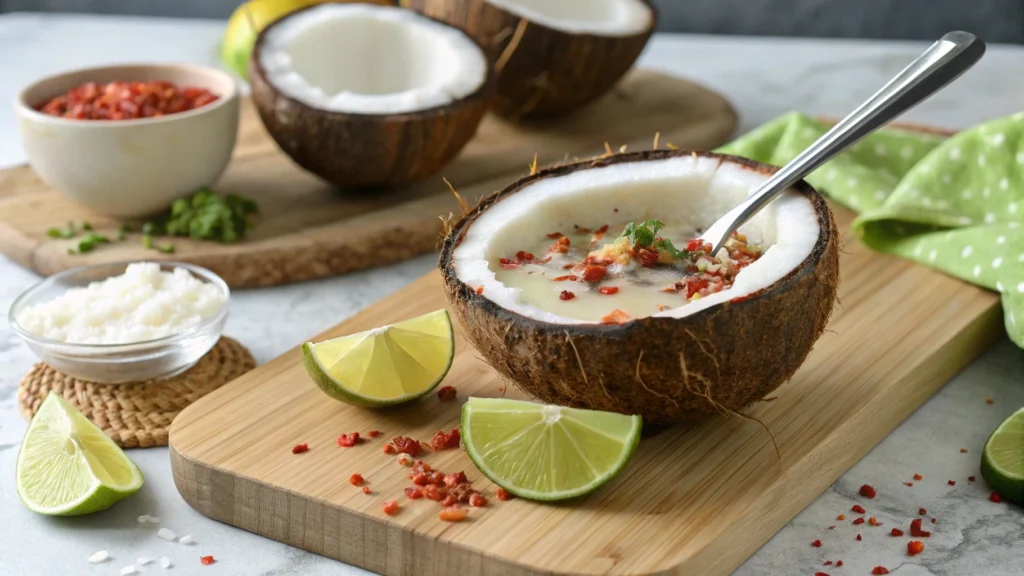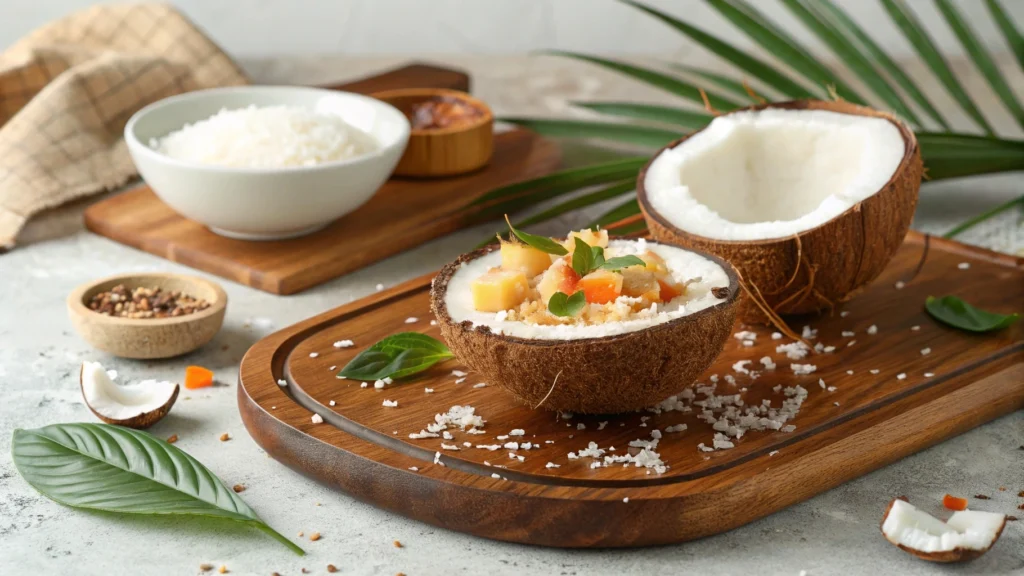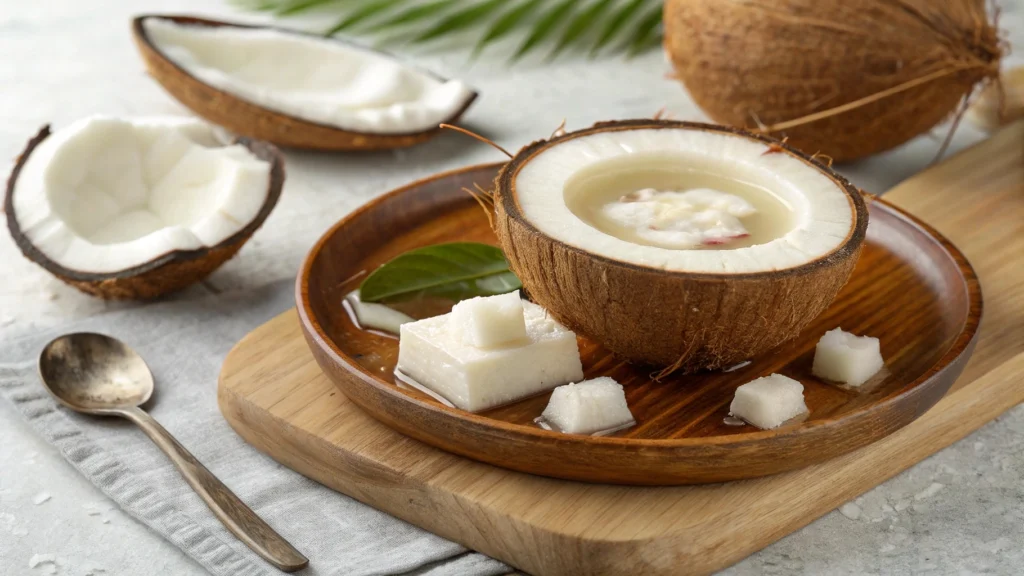Are you ready to transform your mornings into a tropical paradise? Incorporating Coconut recipes breakfast into your breakfast routine can do more than just add flavor—it can supercharge your day with energy and nutrients. Whether you’re a fan of smoothies, pancakes, or on-the-go snacks, this guide will show you how to make every bite count. Let’s dive in and discover why coconut is the ultimate ingredient for your morning meals!

Introduction
Do you ever feel like your breakfast lacks that extra zing? Or perhaps you’re searching for healthier options that still satisfy your cravings? I’ve been there too. A few years ago, I stumbled upon the magic of coconut while experimenting with new recipes. Since then, it has become my go-to ingredient for breakfasts that are not only delicious but also packed with health benefits. In this article, we’ll explore the versatility of coconut and provide you with easy, nutritious, and mouthwatering recipes to kickstart your day.
Key Points Covered:
- Why coconut deserves a place in your kitchen.
- Simple yet flavorful recipes tailored for busy mornings.
- Tips for cooking with coconut products effectively.
Why Coconut is Perfect for Breakfast
Coconut isn’t just a trend; it’s a powerhouse ingredient that offers numerous advantages when incorporated into your breakfast routine. Here’s why it stands out:
Nutritional Benefits of Coconut
Coconut is rich in medium-chain triglycerides (MCTs), which are easily digestible fats that boost metabolism and provide sustained energy. It also contains essential vitamins and minerals such as iron, magnesium, and potassium.
- Boosts Energy Levels : MCTs are quickly converted into fuel by your body, making them ideal for an early-morning pick-me-up.
- Supports Digestive Health : The fiber content in coconut promotes healthy digestion and keeps you feeling full longer.
- Strengthens Immunity : Lauric acid found in coconut oil has antimicrobial properties that support immune function.
Source: USDA FoodData Central.
Versatile Ingredient Options
Whether you’re following a specific diet or simply looking for variety, coconut comes in many forms to suit your needs:
- Coconut Milk : A creamy, dairy-free alternative perfect for smoothies and oatmeal.
- Coconut Flour : Gluten-free and low-carb, great for baking pancakes, muffins, and more.
- Shredded Coconut : Adds texture and sweetness to yogurt, granola, and desserts.
Popular Uses in Breakfast Dishes
Here are some popular ways people incorporate coconut into their breakfasts:
- Blend it into smoothies for a tropical twist.
- Use coconut flour to bake fluffy pancakes or waffles.
- Sprinkle toasted coconut flakes over yogurt or chia pudding for added crunch.
Easy Coconut-Based Breakfast Ideas
Ready to get started? Below are three simple yet satisfying recipes featuring coconut as the star ingredient. Each one is designed to fit seamlessly into your daily routine.
Coconut Smoothie Bowl
This vibrant bowl combines the goodness of coconut milk, frozen fruits, and superfoods for a nutrient-packed start to your day.
Ingredients Table:
| Item | Quantity | Notes |
|---|---|---|
| Frozen Acai Pack | 1 pack | Optional |
| Coconut Milk | 1 cup | Unsweetened preferred |
| Banana | 1 medium | Ripe for natural sweetness |
| Mixed Berries | ½ cup | Fresh or frozen |
| Shredded Coconut | 2 tbsp | Toasted for extra flavor |
| Chia Seeds | 1 tbsp | For added omega-3s |
Instructions:
- Blend all ingredients except toppings until smooth.
- Pour into a bowl and top with shredded coconut, chia seeds, and fresh fruit.
Coconut Pancakes
Who says pancakes can’t be healthy? These light and fluffy pancakes made with coconut flour are gluten-free and incredibly tasty.
Ingredients Table:
| Item | Quantity | Notes |
|---|---|---|
| Coconut Flour | ¾ cup | Adjust based on consistency |
| Eggs | 3 large | Free-range if possible |
| Coconut Milk | ¾ cup | Unsweetened |
| Vanilla Extract | 1 tsp | Pure extract |
| Baking Powder | 1 tsp | Aluminum-free |
Instructions:
- Whisk together dry ingredients in a bowl.
- Add wet ingredients and mix until batter is smooth.
- Cook on a non-stick skillet over medium heat until golden brown.
Coconut Chia Pudding
Perfect for those who love no-fuss recipes, this overnight chia pudding is both filling and refreshing.
Ingredients Table:
| Item | Quantity | Notes |
|---|---|---|
| Chia Seeds | ¼ cup | Black or white |
| Coconut Milk | 1 cup | Full-fat |
| Honey or Maple Syrup | 1 tbsp | Optional for sweetness |
| Vanilla Extract | ½ tsp | Pure |
Instructions:
- Combine all ingredients in a jar or container.
- Stir well and refrigerate overnight.
- Serve cold with toppings like nuts, seeds, or fresh fruit.

Healthy Coconut Breakfast Options
For those pursuing a balanced lifestyle, here are three recipes that align with popular diets like keto, paleo, and veganism.
Gluten-Free Coconut Oatmeal
Kick off your day with a warm bowl of creamy oatmeal enriched with coconut milk and tropical fruits.
- Cook rolled oats with coconut milk instead of water for enhanced flavor.
- Mix in mango chunks, pineapple, or banana slices for sweetness.
- Top with toasted shredded coconut for a delightful crunch.
Low-Carb Coconut Muffins
These muffins are perfect for low-carb enthusiasts thanks to their combination of almond flour and coconut flour.
- Store leftovers in an airtight container for up to five days.
- Reheat in the microwave for 10 seconds before serving.
Coconut Yogurt Parfait
Layer homemade or store-bought coconut yogurt with granola, berries, and spices for a decadent treat.
- Experiment with different combinations of fruits and nuts.
- Enhance flavor with cinnamon or nutmeg sprinkled on top.
Fun Ways to Incorporate Coconut into Breakfast
Breakfast doesn’t have to be boring! Get creative with these fun ideas that bring excitement to your mornings.
Coconut Granola Bars
Make portable breakfast bars using oats, coconut flakes, and other superfoods.
- Combine ingredients in a mixing bowl and press into a baking dish.
- Cut into bars once cooled and store in the fridge.
Toasted Coconut Topping
Add a golden crunch to your favorite dishes with toasted coconut flakes.
- Spread shredded coconut evenly on a baking sheet.
- Bake at 350°F (175°C) for 5-7 minutes or until golden.
Coconut Coffee Drink
Upgrade your coffee game with coconut oil or coconut milk.
- Try bulletproof coffee by blending brewed coffee with melted coconut oil.
- Alternatively, enjoy a latte made with frothy coconut milk.
Tips for Cooking with Coconut
To maximize the potential of coconut in your kitchen, follow these practical tips.
Choosing the Right Coconut Products
Not all coconut products are created equal. Learn how to select high-quality items:
- Opt for virgin coconut oil for its superior taste and nutritional value.
- Choose unsweetened coconut flakes for savory dishes and sweetened ones for desserts.
Storing Coconut Ingredients Properly
Proper storage ensures freshness and longevity:
- Keep coconut milk in the refrigerator after opening.
- Freeze coconut flour or shredded coconut for long-term use.
Experimenting with Flavors
Don’t be afraid to play around with spices and seasonings:
- Balance sweetness with a pinch of cinnamon or cardamom.
- Add a zesty kick with lime zest or ginger.
The Science Behind Coconut’s Health Benefits
Understanding why coconut is such a powerhouse ingredient can inspire you to incorporate it into your diet more frequently. Here’s a closer look at the science behind its nutritional profile:
Medium-Chain Triglycerides (MCTs) Explained
Coconut oil is one of the richest sources of MCTs, which are metabolized differently than long-chain fatty acids. These fats bypass digestion in the stomach and go straight to the liver, where they’re converted into energy.
- Boosts Metabolism : Studies suggest that MCTs may increase calorie burn and fat oxidation.
- Supports Weight Management : Regular consumption of MCT-rich foods has been linked to reduced waist circumference and improved body composition.
Source: Journal of Nutrition Research.
Antioxidant Properties of Coconut
Coconut contains phenolic compounds with potent antioxidant effects. These help combat oxidative stress and inflammation in the body.
- Protects Cells : Antioxidants neutralize free radicals that damage cells and contribute to aging.
- Reduces Inflammation : Chronic inflammation is a precursor to many diseases; coconut’s anti-inflammatory properties can mitigate this risk.
Gut-Friendly Fiber Content
The fiber in coconut supports digestive health by promoting regular bowel movements and feeding beneficial gut bacteria.
- Prebiotic Effects : Coconut flour and shredded coconut act as prebiotics, nourishing probiotics in your gut microbiome.
- Relieves Constipation : Its high fiber content makes coconut an excellent choice for those struggling with irregularity.

Creative Coconut Pairings for Breakfast
While coconut shines on its own, pairing it with complementary ingredients can elevate your breakfast game. Here are some ideas to spark inspiration:
Tropical Fruits
Combine coconut with tropical fruits like mango, pineapple, and papaya for a burst of flavor.
- Blend them into smoothies or layer them into parfaits.
- Use them as toppings for pancakes or chia pudding.
Spices and Herbs
Enhance the taste of coconut dishes with spices like cinnamon, nutmeg, ginger, and turmeric.
- Sprinkle cinnamon over oatmeal or toast topped with coconut yogurt.
- Add fresh mint leaves to coconut water-based smoothies for a refreshing twist.
Nuts and Seeds
Incorporate nuts and seeds like almonds, walnuts, flaxseeds, and chia seeds to boost protein and healthy fats.
- Mix crushed nuts into granola bars or pancake batters.
- Stir chia seeds into overnight puddings for added texture and nutrition.
Budget-Friendly Tips for Buying Coconut Products
Quality coconut products don’t have to break the bank. Here are some strategies to save money while stocking up:
Buy in Bulk
Purchasing coconut milk, flour, or flakes in larger quantities often reduces the cost per unit.
- Look for sales at grocery stores or online retailers.
- Consider splitting bulk purchases with friends or family to avoid waste.
DIY Coconut Milk
Making your own coconut milk from dried or fresh coconut meat is surprisingly simple and cost-effective.
- Soak shredded coconut in hot water, blend, and strain through a fine mesh sieve.
- Store homemade coconut milk in the fridge for up to five days.
Compare Brands
Different brands offer varying prices and quality levels. Always read labels carefully to ensure you’re getting what you pay for.
- Trustworthy brands include Nutiva, Bob’s Red Mill, and Thai Kitchen.
- Avoid products with added sugars or preservatives unless necessary.
Common Mistakes to Avoid When Cooking with Coconut
Even experienced cooks can make mistakes when working with coconut. Here’s how to steer clear of common pitfalls:
Overusing Sweetened Coconut Flakes
While sweetened coconut adds flavor, it can also introduce excess sugar to your recipes.
- Opt for unsweetened flakes whenever possible and sweeten naturally with honey or maple syrup.
Using Too Much Coconut Oil
Coconut oil has a strong aroma and taste, so using too much can overpower other flavors.
- Start with small amounts and adjust based on personal preference.
Ignoring Storage Guidelines
Improper storage can lead to rancidity or spoilage, wasting valuable ingredients.
- Keep coconut milk refrigerated after opening and freeze coconut flour for extended shelf life.
Incorporating Coconut Beyond Breakfast
Once you’ve mastered coconut recipes for breakfast, why not experiment with lunch, dinner, and snacks? Here are a few ideas to keep you inspired:
Lunch Ideas
- Make coconut curry bowls with quinoa, veggies, and tofu.
- Whip up a creamy coconut soup packed with nutrients.
Dinner Ideas
- Try coconut-crusted fish fillets baked with lemon and herbs.
- Serve stir-fried vegetables tossed in coconut oil and soy sauce.
Snack Ideas
- Prepare coconut macaroons or energy balls for quick bites.
- Roast coconut chips seasoned with sea salt or chili powder.

Reader Success Stories
Hearing from others who have successfully integrated coconut into their diets can motivate you to try new things. Below are a few testimonials shared by readers:
Testimonial 1:
“I was skeptical about using coconut flour in my baking, but after trying the pancake recipe, I’m hooked! They’re fluffy, filling, and delicious without any gluten.” – Sarah M.
Testimonial 2:
“Adding coconut milk to my morning coffee changed everything. It tastes rich and creamy, and I no longer need dairy alternatives.” – John D.
The Role of Coconut in Sustainable Living
In today’s world, sustainability is a growing concern for many people. Coconut plays an important role in eco-friendly practices due to its versatility and minimal waste potential.
Zero-Waste Cooking with Coconut
Every part of the coconut can be utilized, reducing food waste and promoting sustainability.
- Coconut Water : Hydrating and rich in electrolytes, perfect for smoothies or drinking straight.
- Coconut Meat : Use fresh or dried for recipes like smoothies, granola bars, or curries.
- Coconut Shell : Repurpose shells as planters, utensils, or decorative items.
Supporting Ethical Sourcing
When purchasing coconut products, look for brands that prioritize fair trade and sustainable farming practices.
- Choose organic options whenever possible to reduce exposure to harmful pesticides.
- Support small-scale farmers who practice regenerative agriculture.
Troubleshooting Common Issues with Coconut recipes breakfast
Even the most enthusiastic cooks encounter challenges when experimenting with new ingredients. Here are solutions to common problems you might face:
Coconut Milk Separation
If your canned coconut milk separates into liquid and cream, don’t panic! This is normal and easy to fix.
- Shake the can thoroughly before opening.
- Blend the contents using a hand mixer or immersion blender if separation occurs during cooking.
Baking with Coconut Flour
Coconut flour absorbs moisture differently than wheat flour, so adjustments may be needed.
- Use less coconut flour compared to other flours (about 1/4 cup per egg).
- Add extra liquid (e.g., water, milk, or applesauce) to achieve the desired consistency.
Preventing Burnt Toasted Coconut
Toasting coconut flakes can quickly go from golden brown to burnt if not monitored closely.
- Toast in small batches on a low heat setting.
- Stir frequently to ensure even browning.
Expert Tips from Professional Chefs: Coconut recipes breakfast
Professional chefs often share insights into how they use coconut in their kitchens. Below are some expert tips to elevate your cooking skills:
Infusing Coconut Flavor Without Overpowering
Subtle additions of coconut can enhance dishes without dominating the palate.
- Add a splash of coconut milk at the end of cooking soups or stews.
- Use toasted coconut flakes sparingly as a garnish rather than a main ingredient.
Balancing Sweet and Savory Dishes
Coconut works beautifully in both sweet and savory applications.
- For savory dishes, pair coconut with spices like turmeric, cumin, or curry powder.
- In sweet recipes, balance sweetness with tangy ingredients like lime juice or yogurt.
Experimenting with Unusual Pairings
Don’t shy away from unconventional combinations involving coconut.
- Combine coconut with dark chocolate for a decadent treat.
- Mix it with avocado for creamy textures in smoothies or spreads.
Additional Resources for Coconut recipes breakfast Enthusiasts
For those eager to dive deeper into the world of coconut, here are some recommended resources:
Books Worth Reading
- “The Coconut Oil Miracle” by Bruce Fife – A comprehensive guide to the health benefits and uses of coconut oil.
- “Coconut Kitchen” by David Lebovitz – A cookbook filled with creative recipes featuring coconut.
Online Communities and Blogs
Join online forums and blogs dedicated to coconut enthusiasts for inspiration and support.
- Reddit communities like r/cooking or r/foodshare.
- Instagram hashtags such as #coconutrecipes or #coconutlove.
YouTube Channels and Tutorials
Visual learners will appreciate step-by-step video tutorials available on platforms like YouTube.
- Search for channels specializing in healthy eating, baking, or tropical cuisine.
FAQ Section: Coconut recipes breakfast
Q: Can I use coconut in any breakfast recipe?
A: Absolutely! Coconut works beautifully in smoothies, baked goods, cereals, and even drinks. Its versatility makes it suitable for almost any breakfast idea.
Q: Is coconut safe for people with nut allergies?
A: Yes, coconut is botanically classified as a drupe, not a nut, so it’s generally safe for individuals with tree nut allergies. However, always check labels for cross-contamination risks.
Q: How can I incorporate coconut into a [coconut recipes breakfast] without overwhelming the flavor?
A: Start small by adding a tablespoon of shredded coconut or coconut milk to your dishes. Gradually increase the amount as you develop a taste for it.
Conclusion: Coconut recipes breakfast
Incorporating coconut into your breakfast routine is easier—and tastier—than you might think. From energizing smoothie bowls to indulgent pancakes, the possibilities are endless. By choosing the right coconut products and experimenting with flavors, you can create meals that nourish both your body and soul. So why wait? Try these recipes today and let us know which ones become your favorites. And remember, the world of coconut extends far
